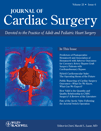Predictors of Postoperative Hematocrit and Association of Hematocrit with Adverse Outcomes for Coronary Artery Bypass Graft Surgery Patients with Cardiopulmonary Bypass
Conflict of interest: None.
Abstract
Abstract Objective: To determine predictors of low intensive care unit (ICU) admission hematocrit, and to determine if low hematocrit is associated with postoperative outcomes for coronary artery bypass graft (CABG) surgery with cardiopulmonary bypass. Methods: We performed a retrospective study of 8417 patients who underwent CABG surgery on cardiopulmonary bypass in New York in 2007. Patients with very low ICU admission hematocrit (≤21.9%) and low ICU admission hematocrit (22.0% to 25.9%) were identified. Significant independent predictors of low and very low ICU admission hematocrit, and the independent impact of each of these states on adverse outcomes were identified. Results: A total of 1.1% had very low hematocrit and 8.3% had low hematocrit. Significant independent predictors for either low or very low hematocrit included older age, females, lower body surface area, lower ventricular function, Hispanic ethnicity, non-Caucasian race, high creatinine, previous cardiac surgery, absence of left main disease, and emergency transfer to the operating room following catheterization or percutaneous coronary intervention. Patients with hematocrit ≤21.9% had significantly higher risk-adjusted rates of postoperative bleeding (adjusted OR = 4.37, 95% CI [1.97, 9.68, respiratory failure (adjusted OR = 2.85, 95% CI [1.45, 5.63]), and one or more complications than patients with normal hematocrit. Patients with hematocrit between 22.0% and 25.9% also had higher complication rates. Conclusion: It is important for cardiovascular surgical teams to be aware of risk factors that predispose patients to unacceptable hematocrit values, to monitor values closely, and to treat accordingly in the operating room when low values occur. (J Card Surg 2010;25:638-646)




